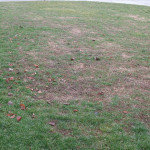IPM – Start Scouting for Problems in the Landscape
Keeping a sharp eye on your landscape is a key part of Integrated Pest Management (IPM). By quickly noticing changes that could indicate problems such as invasive plants, unwanted pests, poor soil quality, inadequate drainage or other issues, you can more quickly take steps to solve those problems with the least invasive method necessary.
How to Scout Your Landscape
Scouting your landscape means you need to be in intimate touch with the changes in your yard, whether it is the growth and health of turf, the bloom and blossom cycle of flowers, growth patterns of evergreen plants or life cycles of insects. All landscapes have natural life cycles and seasonal changes, and you need to be aware of their usual changes in order to spot something different that may indicate a problem. When watching your yard, take careful note of…
Foliage color, shape and condition
- Budding and growth patterns
- Turf density, growth and color
- Bloom density, size and quality
- Fruiting cycles and produce sizes
- Water issues, including standing water or drainage
- Wilting plants
- Plant damage or injuries
- Insect populations and their life cycles
Not all changes are necessarily problems, and the more aware you are of seasonal changes, the more easily you will be able to spot unwelcome issues. It can be helpful to keep records about your landscaping, noting dates of typical blooms or garden progress and other seasonal changes. In time, you will become very aware of the natural cycle of your landscaping, and you will quickly note unusual changes.
When You See a Problem
Seeing a problem is the first step in correcting it, and if you’ve scouted your landscape regularly, you are more likely to notice problems when the solutions may still be simple and easy. When something unwanted happens in your landscape…
- Identify the Issue
To treat a problem effectively, you have to know exactly what that problem is. If you see a new weed or unwanted bug appearing in your yard, for example, identifying the exact pest will help you plan how to control it with the fewest chemicals or least effort so the rest of your landscape is not affected.
- Define Your Tolerance
IPM is all about tolerating a natural landscape, and that occasionally means some pests are allowed in your landscape when they don’t adversely affect the entire yard or garden. A single bug or weed may not be a problem at all, and if it doesn’t take over the landscape, the best action may be to leave it alone. Learn about the potential problem, and decide if it is worth reacting to before taking any action. This could mean scouting the landscape more regularly to note the pest’s progress rather than reacting right away. - Research Multiple Solutions
There are many ways to react to different landscape problems. Some unwanted bugs, for example, could be hand-picked off your plants, or they may vacate your landscape by themselves if you plant different vegetation. Adjusting your watering schedule may make the landscape less inviting, or you may need to try a selective pesticide. Study all the solutions to each problem to understand your options, and how each of those options may affect other parts of the landscape. Will changing your watering cause other plants to wilt? Could a pesticide take away more beneficial bugs? You need to know the answers. - Implement the Solution
Once you understand your options, it is time to take the appropriate steps to keep your landscape in top condition. In some cases, this may mean doing nothing at all if the pest is not a big problem, or else you will need to implement the appropriate solution. Be patient with the results, as it can take some time before the problem is corrected. Keeping records of the changes in your yard can help you see whether your first solution is effective or more aggressive steps may be necessary.
Never Stop Looking
The most important part of scouting your landscape as part of IPM is to never stop looking. Your landscape will change on a daily basis, and you need to be aware of which changes are normal and which may be early indications of problems. Weekly monitoring may be adequate for a healthy, robust landscape, or you may need to carefully check your landscape 2-3 times each week during stressful periods, such as during a drought, after a severe storm or when many plants are young or transplanted. The more aware you are of your landscape, the more easily scouting will help you spot any problems that need care, and the more easily you will be able to keep your landscape healthy and vibrant.
If you have any questions about the information contained in this newsletter, please don’t hesitate to give me a call at 914-377-9039.
Joe Yedowitz, CLT


